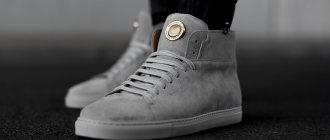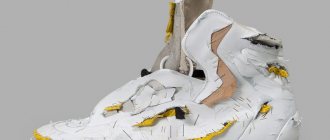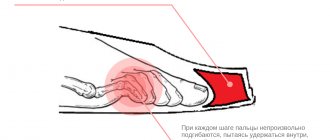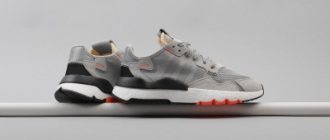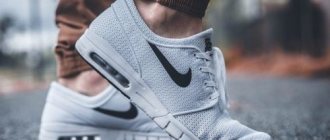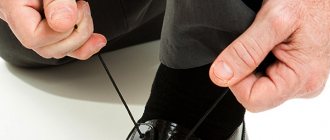Receive one of the most read articles by email once a day. Join us on Facebook and VKontakte.
Who doesn't want to own only quality things? But now the world is ruled by the mass market. And it is somewhat naive to expect quality from Zara sneakers like the latest Adidas collection. Although a reputable brand is by no means a guarantee of quality. If you notice that your sneakers or sneakers are starting to wear out on the backs, then don’t rush to get upset and save up for new ones. This common problem can be dealt with at home. This is what folk craftsmen advise.
The heel of a shoe is the first place to show signs of wear. Especially when it comes to sneakers or sneakers. And while the lining is being wiped from the inside, many ignore the alarm signal. But when the material begins to crack on the outside... To avoid it being too late, take action as soon as you notice the first “symptoms” (as in the photo). And this popular life hack will help you save your sneakers.
1. A fragment of fabric of a similar shade to the backdrop (it is best to use jeans due to its strength and wear resistance);
2. Glue for shoes;
3. Thick needle and thread.
General recommendations
When planning to restore sneakers, you need to take into account that different models differ in the materials used to make sports shoes. Depending on the material, the nuances of further repairs depend. The main task of the work is to update shoes and maintain proper appearance. Without going to a workshop, you can easily glue or extend the sole, whiten the visible part of the products, and eliminate small cracks.
The toe of a sneaker is most susceptible to wear and external influences, which is why tears most often form on it. The toe section is constantly in need of repair due to increased load, so the restoration of this element should be approached with great responsibility.
Even if worn and handled carefully, sneakers will wear out faster than other shoes, especially when used for sports. Prolongation of operation is facilitated by timely repairs and compliance with preventive care measures. This reduces costs compared to purchasing a new pair of sports shoes.
Repair of heel counters in sneakers
It’s a pity to throw away expensive branded sneakers, but wearing them when worn out is unsightly and uncomfortable. How to keep your feet healthy and what to do if the backs of your sneakers rub?
Restoring and restoring your favorite shoes will help preserve their aesthetics and performance.
Most often, repairs to the heel counter of sneakers are required. Airo professionally restores or completely replaces all worn parts. At the same time, the appearance and quality will not differ from the original new pair.
If the heel of your sneakers is seriously worn out, wearing them is dangerous for your feet and uncomfortable. Work on restoring worn-out parts is internal, therefore it is carried out especially delicately and requires high precision of operations.
DIY tread repair
The most vulnerable are the protectors located on the heels of shoes. To restore them, you will need a hard piece of rubber, which can be taken from the sole of unnecessary shoes. Among the tools and additional devices that will be useful for work are: shoe glue, a sharp knife, and coarse sandpaper. The tread repair process is as follows:
- A patch is cut out of a piece of hard rubber and fitted in place of the damaged or worn out tread.
- Using a knife and sandpaper, make a wedge-shaped patch.
- The surfaces that will be glued are treated with sandpaper to roughen them, and then wiped with a solvent and allowed to dry.
- The adhesive composition is applied in two layers to the patch and the future location of the protector. The drying time of the first layer should be about 20 minutes, the second - 4-6 hours.
- After the glue has dried, the surfaces are heated over the stove until a smell appears, applied to each other, squeezed tightly and held until cool and fixed.
How to fix a hole in the sole of a shoe
Instructions for fixing a hole in the sole of a boot:
- Remove the insole from the shoe.
- Press the hole from the inside using a small piece of leather.
- Squeeze glue into the hole. The resulting hole should be completely filled.
- It is necessary to hold the piece of leather until the glue hardens. It is important to firmly squeeze the gluing area. Approximate time – 10-15 minutes.
- Turn the boot over to distribute the glue evenly.
- Wait for the adhesive to completely harden.
- Cut off the layer of leather inside the shoe.
- Place the insole in its original place.
Important point: when working with glue, you should use gloves and a respirator.
You can repair damage to the sole of a shoe using a soldering iron.
To do this you need:
- Wash the boot thoroughly.
- Degrease the surface.
- Run a hot soldering iron inside the crack. As a result, bubbles will appear on the top of the material.
- Fill the hole with melted nylon.
The method with a piece of leather is suitable for a hole of several millimeters:
- Clean the sole from dirt.
- Treat the surface with acetone.
- Sand the sole using sandpaper.
- Cut a patch from leather.
- Glue the workpiece to the damaged area.
- Wait several hours: the glue must dry completely.
The advantages of the method are speed, simplicity, and low cost. Disadvantage : fragility (the leather will quickly deteriorate).
How to repair heels
To repair heels on sneakers, you need to get rid of the old tread, tearing it off the sole, cutting it in places where it is impossible to separate the element manually. To simplify the task, you can treat problem areas with a solvent.
After removing the tread, the contour of the sole is transferred to thick paper or cardboard and the erased edges are completed. Having drawn the outline, the pattern is cut out of paper and used to create a new blank. You can make the sole from a rubber mat, which is sold in hardware stores. It is impractical to partially restore the sole, so if the heel of the sneakers is damaged, the base is completely changed.
When gluing the sole to the main part of a sports shoe, you need to thoroughly clean the surface. Otherwise, the gluing procedure does not differ from the standard one.
How to repair the top
The features of repairing the upper part of the sneakers directly depend on the material used. If shoes are made of suede, natural or artificial leather, then the material wears out over time and cracks at break points. To restore the appearance, patches made of thin and elastic material can be glued or sewn onto cracked and cracked areas. Before applying patches, the old material is torn off.
The use of patches on the upper part of the sneakers ruins the original appearance of the shoes, so it is better to prevent cracks from occurring. To maintain shoes in good condition, natural leather should be periodically lubricated with cream, and suede should be cleaned with a dry, stiff brush, trying to lift the pile. To clean the upper part of your sneakers from dirt, you should use a damp cloth rather than washing your shoes under running water.
The most resistant materials
Polyurethane (PU) soles
Polyurethane has good performance properties: it weighs little because it has a porous structure, has good abrasion resistance, is flexible, has excellent shock absorption and good thermal insulation. The soles made of polyurethane are light and flexible, therefore they are used in shoes where these characteristics are of particular importance.
Disadvantages: The porous structure of polyurethane is also a kind of flip side of the coin. For example, because of it, polyurethane soles have poor grip on snow and ice, so winter shoes with PU soles slip a lot.
Soles made of polyvinyl chloride (PVC, PVC)
PVC soles resist abrasion well, are resistant to aggressive environments and are easy to manufacture. They are often used in household and children's shoes, and previously they were especially widely used for safety shoes, since when mixed with rubber, PVC acquires properties such as oil and gasoline resistance.
Disadvantages: PVC is used only in the production of casual shoes for autumn or spring, because this material has a large mass and low frost resistance, unable to withstand temperatures below -20 degrees.
Tunit soles
Tunit is rubber with the inclusion of leather fibers, so the second name for this material is “leather fiber”. In appearance, hardness and ductility, tunit soles are similar to leather ones, but they behave better in use: they hardly wear out or get wet. These soles are easy to apply texture to, which gives them a little more grip than leather.
Disadvantages: But even despite this, shoes with tunit soles are very slippery due to the high rigidity of the material. Therefore, tunit is used in the manufacture of only summer and spring-autumn shoes using the adhesive fastening method.
Video
Sole
The quality and condition of the sole affects the comfort when wearing sports shoes. With prolonged use, the sole of the sneakers wears out and becomes deformed. Stepping on stones and unpaved surfaces risks damaging the sole, causing holes to form on it.
How to seal a hole
Any holes in the sole can be repaired in different ways, depending on the base material of the sneakers and the extent of the damage. Most often, epoxy glue is used to eliminate holes, which is relatively affordable and easy to use. Holes on the sole are sealed as follows:
- all edges of the hole are well cleaned and treated with a solvent to degrease;
- when the area next to the defect is completely dry, apply the diluted adhesive composition;
- if the hole in the sole of the sneaker is too large, a fiberglass mesh is placed in it to fill the void;
- when the glue dries, cover the damaged area from the outside with masking tape to level the sole;
- The sneakers are left in a well-ventilated area to dry completely.
How to increase worn out
If the soft sole of the sneakers has worn down slightly, it can be increased to its original thickness. For this purpose, you will need to purchase microporous rubber. A blank is cut out of the material in the shape of the worn-out element, the surface is cleaned with sandpaper and glued to the shoes.
It is better to use a special kind of shoe glue as glue to ensure reliable adhesion.
Replacement
A sole with a lot of damage is easier to replace with a new one. This will significantly reduce the time spent on repairing each damaged area. The replacement sole, as well as for extension, is cut out of microporous rubber. The sneaker is applied to the cardboard and the outline is outlined, and then it is transferred to the prepared material and the blank is cut out.
The advantage of using microporous rubber to create a new sole is the ability to cut parts into different shapes and sizes. The material can be used to make the sole of the desired type at minimal cost. In addition, microporous rubber has the following performance characteristics:
- light weight, strength and elasticity;
- resistance to rapid erasure;
- anti-slip;
- immunity to various atmospheric phenomena;
- no need for additional processing.
Your benefits when contacting us
The Airo company works with all colors, even complex ones - white, silver, so the restoration of sneakers is in demand by our clients in Moscow.
A convenient work schedule – from 10 to 23 hours – is preferable for busy people and organizations. The prices for the complex of works are agreed upon with the client in advance, and payment is made after receiving the restored pair.
For orders over 2,190 rubles, delivery in Moscow is free. If the cost of the work is less, the payment for courier services will be 390 rubles. Among our other advantages, we should note a wide range of services and the location of a repair shop and dry cleaning near the metro station.
Combination top repair
On sneakers with a combined upper made of synthetic material with foam padding or natural and artificial suede, the fabric most often damaged is in the toe area, where the shoe comes into contact with the toes. On the outside, this area can be protected by a rubber insert around which there is a mesh, which is typical for running models of sneakers.
If there is minor damage to the front of the shoe, a patch can be sewn on. If there are large holes, you need to prop up the seams, adjust the size and shape of a piece of durable nylon fabric and sew it in place.
How to seal a sole with voids
Sneakers with honeycomb-shaped soles are often found. In such shoes, voids may appear.
Repair algorithm:
- Bend the insole.
- Fill the resulting voids with scraps of elastic.
- Secure the filler with sealant.
- Degrease the surface after the sealant has hardened.
- Glue the insole in its original place.
Read more ► How to soften your shoes so that they don’t cause calluses on the back; you don’t want to throw your shoes away?
How to fix a backdrop
Damage to the back of sneakers manifests itself in different ways: the fabric tears, the inner lining comes out, and discomfort appears in the heel.
When repairing shoes at home, you can take the following steps:
- Carefully cut off the torn edges in the area where the lining is located.
- Select a piece of thin leather that is soft to the touch and cut the blank in the shape of a small horseshoe. This shape is required to cover the entire surface of the heel of the sneaker.
- Treat the leather blank with shoe glue, thoroughly covering the entire surface, especially the edges.
- Carefully apply the patch to the heel of the shoe and place any suitable size object inside the sneaker to spread and press the fabric tightly.
- Leave the shoes for several hours for the final fixation of the patch.
What to do?
- Put heels on shoes. Any local shoe repair shops will do just that. They put a heel on you (in the heel area or in the toe area, where the sole also often wears out) and you wear it out again. When you erase it again, install a new one!
- Change your gait. The fact is that the very process of wearing off the sole of a shoe usually causes walking on asphalt. And here there is a nuance, for some it is erased, for others it is not. It's all in the gait! Analyze how you walk. Walk and think about the responsibilities of your steps and your posture (your back should be elongated and straight, your shoulders should not be sloping). If the sole of your shoe wears out in the area of the toes and below, no matter what your weight and height, most likely when you take a step, you lean forward a little, and during the step itself, transfer your body weight from the heel to the foot and push off with the area of the foot below the toes – press the sole to the asphalt and wash it off.
Tip: Keep your weight on your heel as you push off, gently transfer your weight from your heel to your entire foot. The gait should be as relaxed as possible. As the step transitions to the foot itself, simply step on it softly and transfer your weight to the new heel of the next step.
- Choose shoes with good soles. The sole is one of the most important parts of the shoe, which protects it from wear and largely determines its service life. It is the sole that is subjected to intense mechanical stress, abrasion on the ground and repeated deformations. Therefore, the materials used to make soles must be as resistant to environmental influences as possible.
How to reduce the number of cracks
A common cause of cracks in sports shoes is improper use. In particular, defects appear on sneakers due to wearing shoes of a larger size, excessive bending of the foot while wearing, prolonged pressure, exposure to high or too low temperatures.
If you follow the rules for using shoes, cracks will appear on them in a minimal amount.
To reduce the number of damages, it is recommended to use special mold holders, blocks and spacers during storage. It will also be useful to stuff the sneakers with crumpled paper to flatten the shells. Another factor that leads to the formation of cracks is soiled shoes. When a large number of dirt particles accumulate, the number of cracks increases and they grow faster. For this reason, the products should be kept clean.
How to properly care and wear
To extend the service life and maintain the proper appearance of your sneakers, you need to follow a number of simple rules. In particular:
- Take off and put on sneakers unlaced. If you do not untie the laces, the resistance on the heel will increase, which will cause its deformation.
- Only wear shoes that are the right size. Otherwise, abrasion will occur faster.
- Use the correct type of running shoes. For running, training and everyday life, appropriate types of shoes have been developed, so you should not limit yourself to one pair, but choose a separate option for each type of activity.
- Buy quality shoes. Attempts to save money often lead to accelerated wear and tear and the appearance of a large number of defects, as a result of which you have to constantly carry out restoration or throw away the sneakers.
Why does the mesh wear out and tear?
The vulnerable and short-lived part of sports shoes that often wears out is the mesh. The causes of damage are as follows:
- Features of the legs . Some people's legs have structural features that differ from the standard ones. This could be a protruding toe, a bunion, or an atypical foot shape. Where the foot presses on the shoe more than necessary, the mesh breaks faster.
- Sloppy walking . Sometimes people move quickly, do not look at their feet, often stumble or hit one foot against the other when walking. These actions ultimately lead to damage to the shoes.
- Active lifestyle . Hiking, mountain climbing, and even long walks around the city can take a toll on your sneakers, causing them to quickly lose their appearance.
- Frequent washing . If the shoes are light, you have to clean them almost every day. To prevent regular exposure to brushes and detergents from damaging the mesh, you should use special soft rags, sprays or wet wipes, and it is better to completely wash your sneakers as rarely as possible.
- Accident . No one is immune from small incidents. If a person accidentally stumbles, hits or even touches the mesh with something, it can tear, especially if it is made of thin material.
- Weather . Rain, snow, dirt and other natural factors often negatively affect the condition of the fabric of sneakers. The mesh becomes thinner and wears out faster.
- Sports . Those who love to exercise need to be prepared for damage to their sneakers. Football, volleyball and even running wear out shoes more than walking. In this case, it is better to have a special pair for physical education.
On cheap shoes, the mesh breaks faster, but the high price also does not protect against the risk of damage.
Why does this happen?
- The most common option is poor quality shoes. If the materials from which the shoes were made are of very low quality, then the shoes will quickly wear out at all places where they are folded.
- Health. About 80% of the population have various types of foot deformities to one degree or another. In accordance with the characteristics of gait, overload zones appear in the areas of “shifts” of the pressure curve, and at a certain age, corns form. The skin of the outer edge of the heel, the forefoot, and the inner edge of the big toe are especially affected. This is where excessive shoe wear occurs. Most often, excessive shoe wear causes flat feet. With this disease, a person simply cannot place his foot correctly and evenly, as a result of which the shoes quickly lose their shape and wear out. The same goes for the heel. If the shoe itself is severely deformed, then the heel begins to wear out.
- Influence of type of activity. Many dancers who wear professional dance shoes complain that even expensive ballet shoes wear out quickly. The reason here is that dancers have too much mobility in their feet. Even when walking normally, they arch their foot, causing the heel to rub. But most often car drivers face this problem. When you constantly press the gas brake pedal, the heel rubs against the plastic. To avoid this, you just need to drive the car more carefully and watch where your foot is positioned on the pedals. If you can’t do this, then special “overlays” for shoes are sold for such cases. They are easy to put on any shoe. Made from a variety of materials and colors, this type of “shoe” for your shoes will protect them and extend their lifespan.
What to do if the mesh on your sneakers is frayed or torn
Even the best quality sneakers can tear or become damaged. To avoid throwing away a good pair of shoes, you should try to repair them yourself.
Sew with thread if a small area is torn
You need to take a thread that matches the color of the sneakers and a needle. A needle is inserted into the holes in the mesh and gradually pulls the material until the seam hides the torn area. You need to sew not along the edge of the hole, but a little further, capturing more fabric. This will prevent the shoes from tearing again when worn. When the seam is completed, you need to tie a tight knot and trim off the unnecessary part of the threads.
The seam should be small and tight. This way it will look neater and last longer.

